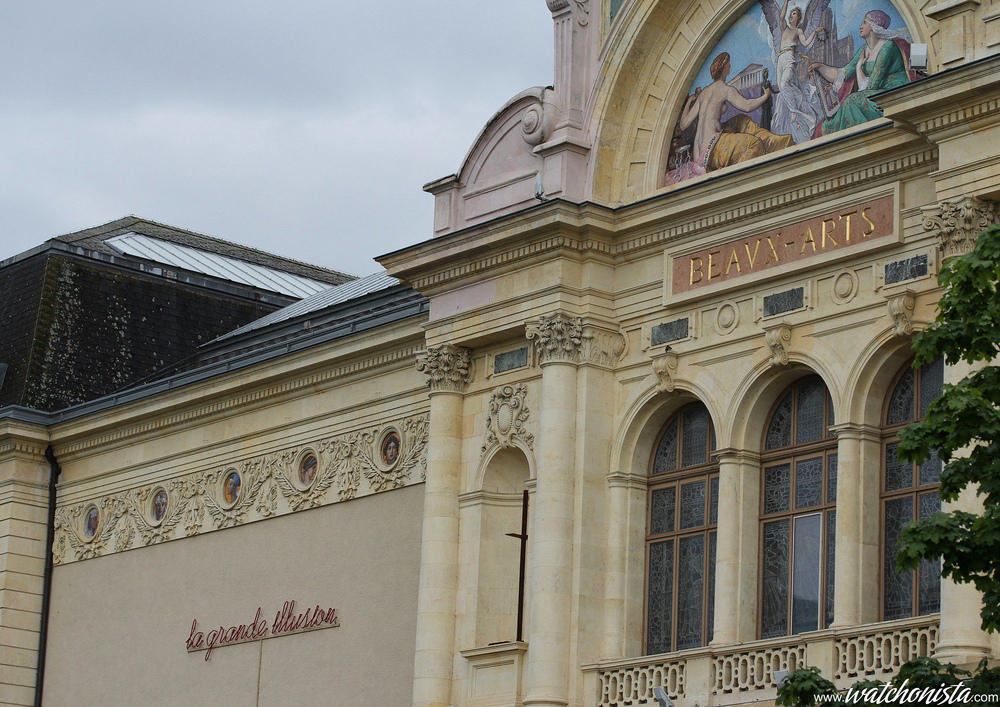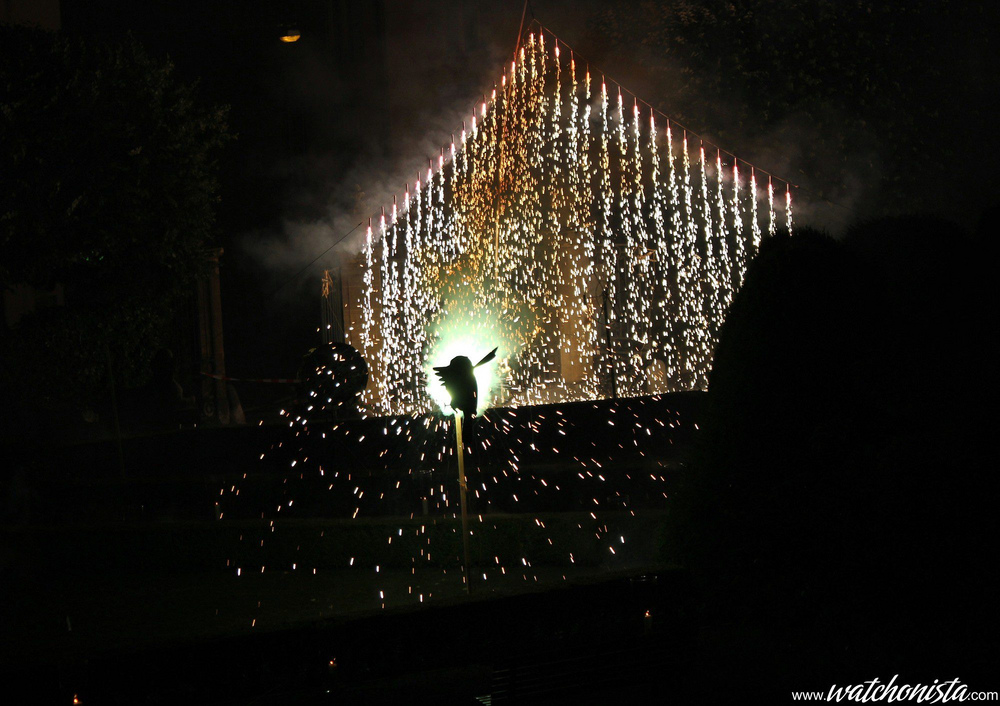Finally, the attraction of the exhibition, the masterpiece among Jaquet-Droz's creations: the "Writer" android, kept in the Art and History museum of Neuchatel. This building is fascinating, because it was designed and built from the beginning as a museum, which was extremely rare prior the 20th century.
It is also a perfectly preserved testimony to the arts and crafts period of the 19th century; the main entrance features a triptych of allegoric frescos about the arts, industry and religion, which were the patrons' fundamental preoccupations.
The MAHN also houses very fine creations from the Jaquet-Droz family. For example, a vestibule clock, which looks like a singing bird cage at a 1/1 scale, the center of the cage featuring crystal rods which picture water jets. When the birds sing, the crystal rotates and the "watery" effect is stunning.
There are also more classical pieces, such as a walnut clock created by JF Leschot, with magnificently designed hands.
Finally, one of the most fascinating pieces is part of the Patek museum collection; it is a coach watch named "The birds", which features six complications: moon phase, GMT, alarm, hour strike, "to order" repeater and flying second!! A true personal assistant from the beginning of the 19th century.
But this amazing horologic work gives way to the technical feat called "«L’ecrivain»"; as explained earlier in the topic, it is a major innovation in the domain of computers and it is, by far the most complex of Jaquet-Droz's creations (About 6000 parts, compared to 600 in a contemporary Grande complication).
The way we consider this android is undoubtedly very different from the way our ancestors did. Indeed, from a watch lover's standpoint, the sight of the android conscientiously writing a text of 43 customized characters with a quill, gives way to the sight the working mechanism. The concept of 3D, which is at the core of modern watchmaking and at the core of professional and leisure robotics, took a tangible form with this type of automaton.
The 40 cams are controlled by a customizable disc sitting at the bottom of the android's back (26 small and 14 capitals); They hold all the data which allow «L’ecrivain» to write in abscissa, ordinate and to control the pressure transmitted to the stroke. Therefore, the mechanism must be designed to be adaptable and accurate enough to manage very diverse data depending on the text. When one knows that in a watch movement, every wheel sits at a defined place, with defined teeth, in order to manage linear data, one realizes just how amazing a feat JAQUET DROZ accomplishes in 1773!
Because to be able to develop such an automaton (it took five years), Jaquet-Droz had to ignore a large part of the rules of horology, and had to rely on other specialties such as anatomy, as the structure of the automaton's arms was inspired by the flesh and bone.
For that matter, Pierre Jaquet-Droz was a recognized prosthetics technician; thus, he could utilize his medical knowledge to create the automaton. And certain aristocrats and the bourgeois from Europe flocked to his dwelling in the mountains to benefit from his medicine. If some came to seek the care of JAQUET DROZ, others made the trip to see his automatons in action. Indeed these pieces were also the ancestors of the "Talking-pieces", so dear to the contemporary watchmaking tradeshows.
And this vocation is still ongoing: as a part of the partnership with "Automates et Merveilles", Jaquet-Droz has invited the collectors, the journalists and some of the horologic blogosphere to an event intended to give media coverage to these vintage "Talking-pieces". And, in conditions of comfort and security inconceivable in the 18th century, we attended the opening cocktail of the exhibition of Neuchâtel. It was followed by a dinner at the Hôtel du Pérou. Finally, a custom fireworks display right in Neuchâtel and some animations of Singing Birds (one of the specialties of the JAQUET DROZ family) were the highlight of the evening.
Thiebault Benz (Jaquet-Droz), Ariel Adams (A Blog to Read), Marc André Deschoux (The Watch TV, Alexander Friedman (Watchonista)
The next day, we had the opportunity to visit the MIH and the château des monts, under a magnificent sun. It has been a delight to benefit from Vincent Davaux's knowledgeable commentaries and to meet our friends from the Parisian horlogical web.
The French horological web by Toutatis from Passion Horlogère: Vinvent Daveau (L'express), Malik "pifpaf" Bahri (Watchonista), René Giroud (Pole Horlogerie), Jean-Philippe Tarot (Montres de Luxe), Thomas Gisclard (The Watch Observer), Stephan Ciejka (La Reveue des Montres)
The exhibition will be held until September 30th, with many demonstrations of the automatons planned. For the European enthusiasts, it would be a shame not to attend this event, as not only do these androids represent a major turning point for the watchmaking industry, but also for many artistic or scientific specialties. Furthermore, traveling to the Canton of Neuchâtel has become easy. For those of you who are far away, I hope you will have as much pleasure reading this article as you would attending "Automates & Merveilles".

 Registracija
Registracija Help
Help


 2Likes
2Likes LinkBack URL
LinkBack URL About LinkBacks
About LinkBacks


















 Odgovor sa citatom
Odgovor sa citatom
Bookmarks sajtovi